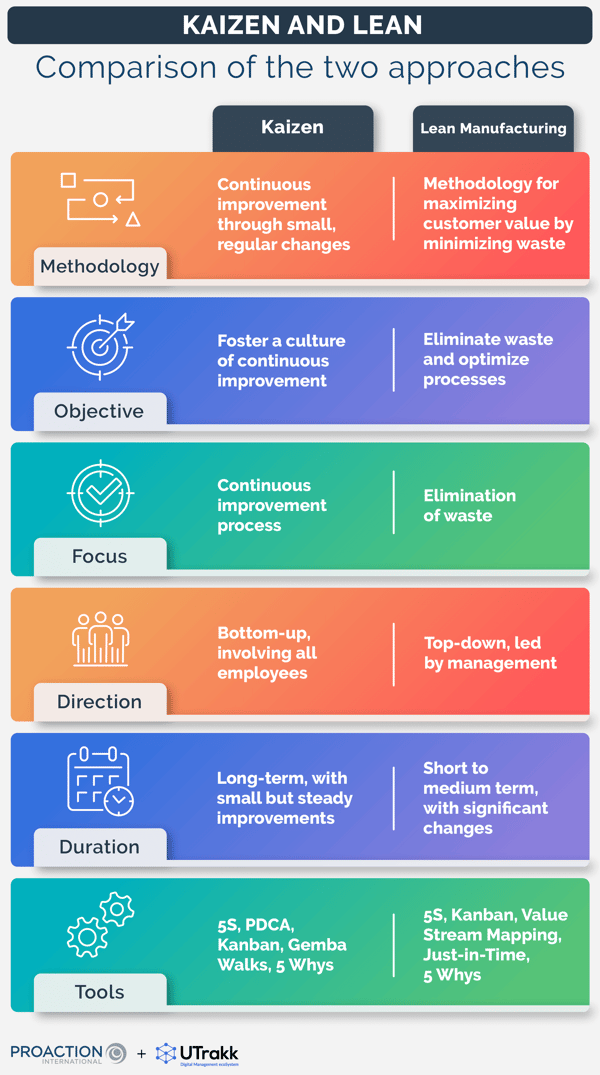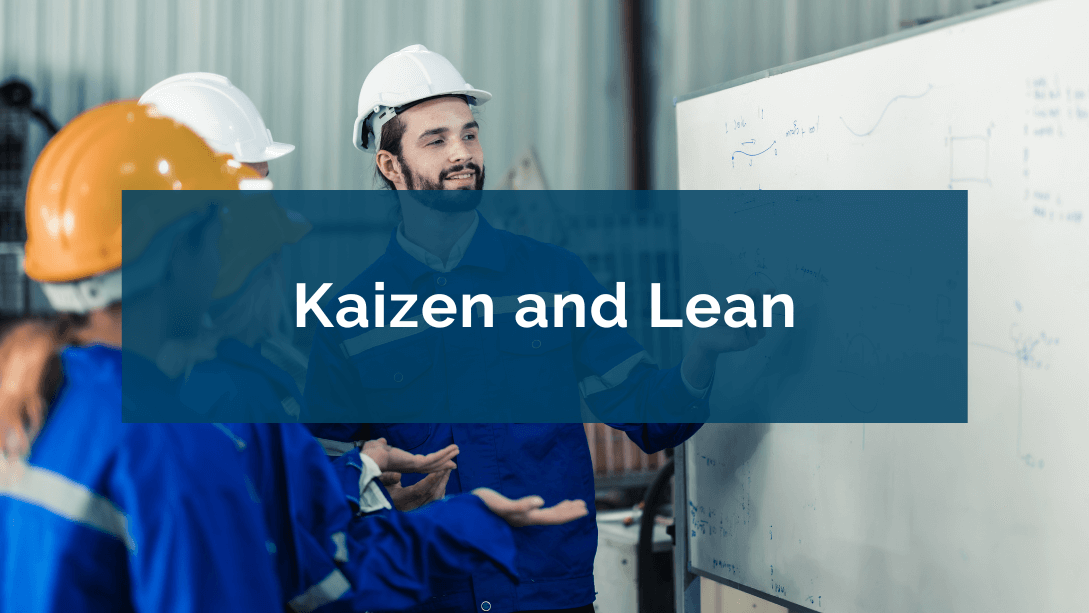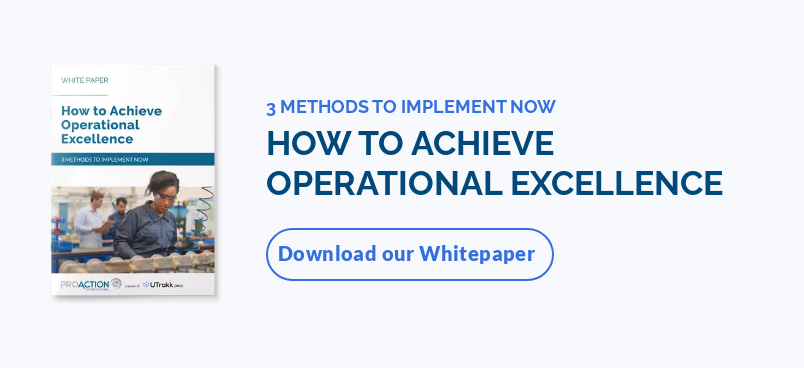What is the Kaizen method?
The Japanese term Kaizen (kai and zen, meaning "change" and "better," respectively) refers to the principle of continuous improvement. Masaaki Imai (founder of the Kaizen Institute) popularized the kaizen philosophy worldwide, notably through his book Kaizen: The Key to Japan's Competitive Success.
Kaizen is a way of doing things, a state of mind that must be cultivated daily within an organization. It is based on the idea that small, incremental improvements can bring about significant change over the long term. This gentle, progressive methodology is thus opposed to the concept of throwing everything out and starting again with something new, often found in Western countries.
The primary goal of the Kaizen approach is to continuously improve processes with the active participation of everyone in the organization.
Kaizen is based on these fundamental principles:
- Continuous improvement: Rather than seeking spectacular improvements, Kaizen focuses on small, ongoing changes.
- Collaborative approach: Every employee, whatever their level, is invited to identify problems and find solutions.
- Clean and orderly work environment: Waste reduction and work organization create a clean, tidy, and safe environment.
Continuous improvement tools
- 5S method: A method for organizing workspaces efficiently and safely by applying the five steps: Seiri (Sort), Seiton (Set in order), Seiso (Shine), Seiketsu (Standardize), and Shitsuke (Sustain).
- Kanban: A visual workflow management system used to identify inefficiencies and improve existing processes.
- PDCA (Plan-Do-Check-Act): Continuous improvement cycle used to systematically test and implement solutions.
- 5 Whys: Problem-solving method based on asking the question "Why?" five times to identify the root cause of a problem.
- Gemba Walks: Visits to the workplace to observe current production processes and discuss with employees to understand real challenges and identify ideas for improvement.
- Poka-Yoke: A technique for preventing human error by designing processes to make it difficult or impossible.
What is Lean Manufacturing?
Lean Manufacturing also originates from Japan, in the Toyota production system. It is a method of production management and work organization designed to eliminate waste ("muda" in Japanese), maximize customer value, and improve operational efficiency.
Lean methodology is based on five fundamental principles:
- Define value from the customer's point of view.
- Mapping the value chain to identify all unnecessary steps.
- Establish a continuous production flow.
- Create a pull system where production is based on actual demand.
- Cultivate continuous improvement.
Lean Manufacturing tools
In addition to 5S and Kanban, Lean also uses tools like:
- Value Stream Mapping (VSM): A process mapping method to identify and eliminate waste.
- Just-in-Time (JIT): Just-in-time production system to reduce excess inventory and improve efficiency.
- 5 Whys: Problem-solving method based on asking the question "Why?" five times to identify the root cause of a problem.

How Kaizen reinforces the principles of Lean Manufacturing
Although two distinct methods, Kaizen and Lean Manufacturing, are highly complementary. Indeed, the former brings a culture of continuous improvement that is essential to the long-term success of the latter. Here are the main points on which they reinforce each other:
Creating a culture of continuous improvement
By integrating Kaizen, which encourages all employees to actively participate in improvements, Lean Manufacturing ensures that process optimization and eliminating non-value-added activities are constantly supported. The result is greater, sustainable efficiency.
Example
An employee notices that certain tools are often misplaced in an automotive parts manufacturing plant, causing delays. Using Kaizen, he suggested setting up a 5S station to systematically organize and put away the tools. This small improvement supports Lean principles by reducing downtime and improving overall efficiency.
Identifying and reducing waste
While Lean identifies waste, Kaizen provides techniques and tools to eliminate it on an ongoing basis.
Example
A furniture manufacturing company uses Value Stream Mapping (a Lean tool) to identify a bottleneck in its production line. Using the 5 Whys of Kaizen, the team discovers that the problem stems from a poorly optimized assembly step. They then apply PDCA to test and implement a new procedure that eliminates the bottleneck, thereby reducing production cycle time.
Engaging employees
By involving all employees in Kaizen's continuous improvement initiatives, Lean Manufacturing benefits from a motivated and proactive workforce to identify and resolve inefficiencies.
Example
In a food production plant, production line employees participate in regular Kaizen events (also known as “kaizen blitz” or “kaizen workshop”), where they are encouraged to propose ideas for improving efficiency and solving problems. During one of these events, an operator suggests reorganizing the equipment layout to reduce travel time between different production stages. Once tested and implemented, this suggestion reduces the production time of each batch and improves overall efficiency.
By directly involving employees, the company benefits not only from new ideas for improvements but also from a more motivated team invested in the success of Lean initiatives.
Benefits of combining Lean-Kaizen methods
Increased efficiency and productivity
By combining these two principles, organizations can achieve superior operational efficiency. Small, incremental changes (Kaizen) integrate perfectly with large-scale streamlining initiatives (Lean), leading to increased productivity.
Quality improvements and waste reduction
Kaizen encourages early detection of defects by involving all employees in the improvement process. Combined with Lean techniques, this significantly reduces defects and improves the quality of finished products.
Reduced costs and increased profitability
Eliminating waste (Lean) and continuous improvement (Kaizen) reduces production costs. This enables companies to increase profitability while offering higher-quality products.
Improved employee involvement and well-being
Kaizen creates a work environment where every employee feels valued and involved in the improvement process. This not only leads to higher well-being but also to greater engagement and motivation, which is essential for the long-term success of Lean initiatives.
Better customer satisfaction
Implementing Kaizen and Lean Manufacturing methodologies not only enhances operational efficiency but also significantly boosts the satisfaction levels of customers by consistently delivering high-quality products and services.
Flexibility and adaptability
By promoting continuous adjustments with Kaizen, Lean Manufacturing remains agile and can adapt quickly to market shifts, demand fluctuations, and new customer needs.
UTrakk, an indispensable tool to guide you through continuous improvement
UTrakk Daily Management System (DMS) offers the features you need to implement and maintain continuous improvement in your organization. Our dashboards, digital Gemba Walks, action and meeting management functions, and Knowledge Center empower you to:
Identify variances
Quickly spot variances from established standards with Gemba Walk checklists embedded in digital audits and floor tours, and user-friendly, interactive dashboards. These features make it easy to make decisions and implement strategically-targeted corrective actions.
Solve problems
With UTrakk, you can create and track action plans in a structured way, enabling you to solve problems quickly and efficiently. This results in reduced downtime and inefficiencies.
Our solution supports problem-solving tools and methodologies, including DMAIC, PDCA, 5 Whys and QRQC.
Set up a continuous improvement committee
The DMS lets you structure continuous improvement committee meetings, providing a framework for managing and monitoring actions and opportunities. During these rituals, teams can monitor key performance indicators (KPIs) and pinpoint problems, track progress on actions, assign tasks and priorities, and review project status – all from the Rituals module interface.
Track results
UTrakk dashboards provide clear visualization of the results of improvement initiatives in comparison with set KPIs; diagrams and global indicators show data in red if below target, or green if above. Progress and impact are accurately tracked, making it easy to identify opportunities and target areas where adjustments are needed.
Standardize and document processes
Once improvement solutions have been implemented, our Knowledge Center allows you to document, standardize, and update processes and procedures, ensuring that best practices are adopted and maintained throughout the organization.
Towards continuous excellence with Kaizen and Lean methods
Kaizen and Lean Manufacturing are not just management methods; they are working philosophies that are transforming the way manufacturing companies operate. By combining continuous improvement with the systematic elimination of waste and focusing on customer value, they help create more agile, efficient, and responsive production environments. At the same time, they create a more dynamic, inclusive, and motivating working environment by involving all employees in the improvement and problem-solving process.
Beyond the operational and human gains, Kaizen and Lean methodologies prepare companies to meet tomorrow's challenges by developing adaptability and resilience in the face of rapid market change. Investing in these approaches means committing to the path of sustainable operational excellence, where every day offers a new opportunity to do better and grow.









